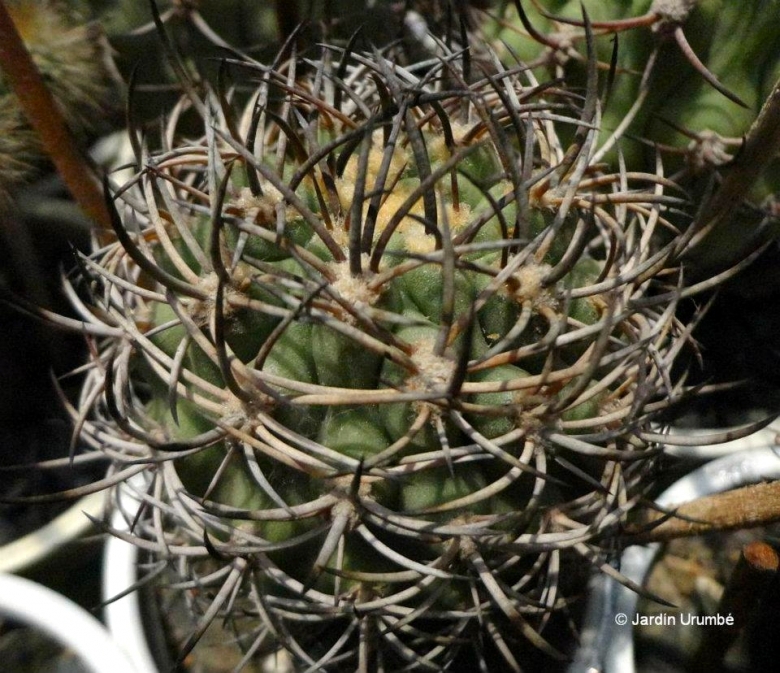= Eriosyce algarrobensis F.Ritter
Kakteen Südamerika 3: 914 (1980)
Accepted Scientific Name: Eriosyce aurata (Pfeiff.) Backeb.
Cact. Journ. Brit. v. 9, fig. sub nomine Morawetzia Doelziana (1936); et inBlatter Kakteenforsch. 1937, No. 1, p. [8].

Eriosyce sandillon var. algarrobensis (Eriosyce algarrobensis) Photo by: Alexander Arzberger
Origin and Habitat: South of Mina Algarrobo, Depart. Huasco, 03 Atacama, Chile.
Synonyms:
See all synonyms of Eriosyce aurata
back
Accepted name in llifle Database:Eriosyce aurata (Pfeiff.) Backeb.Cact. Journ. Brit. v. 9, fig. sub nomine Morawetzia Doelziana (1936); et inBlatter Kakteenforsch. 1937, No. 1, p. [8].Synonymy: 34
back
Description: Eriosyce algarrobensisSN|2340]]SN|2340]] is a globular, solitary species that produces splendid grey-brown spines bent toward the stem and upward. It is generally included within (as a synonym of) Eriosyce aurataSN|2326]]SN|2326]], suggesting that there is not really a fundamental difference between the two. The key difference by which this species was separated, namely: its much smaller size (less than 15 cm thick), larger areoles, more numerous radial spines and different seeds, appears to fall within the natural variation of Eriosyce aurataSN|2326]]SN|2326]] and it should be synonymized with the latter. It is at most a race of Eriosyce aurataSN|2326]]SN|2326]], but it still has a value for a collector because they identify plants with particular characters.
The following description is mainly based on Eriosyce algarrobensisSN|2340]]SN|2340]] F.Ritter 1980 (Collector's number referred here is FR 1456 südlich der Mine ALGARROBO, Depart. Huasco. ).
Stem: Green, globular, 8-15 cm thick.
Ribs: 15-27, crenate, 8-15 mm high, depending on age, notched, thickened at the humps.
Areoles: 10-20 mm long, 4-7 mm wide, very close (a few mm) from each other,
sunken into the notches, pale brownish, becoming gray.
Spines: Subulate, at first grey brown, becoming grey.
Radial spines: 12-18, 10-35 mm long, curved toward the stem and semi-spreading.
Central spines: 2-7, 2-4 mm long, not clearly separated from radials, in juvenile (not flowering) specimens 2-3, increasing to 5-7 later, and bent upward.
Flower buds: Heavily wrapped in white wool and pale, hardly stinging bristles 10-15 mm long.
Seeds: Dull black, bag-shaped, little keeled on the back, ca. 1,8 mm long, 1,6 mm wide, 1,2 mm thick.
Subspecies, varieties, forms and cultivars of plants belonging to the Eriosyce aurata group
 Eriosyce algarrobensis F.Ritter: has stems less than 15 cm thick, larger areoles, 12-18 radial grey-brown spines and different seeds. Distribution: South Algarrobo, Depart. Huasco, Atacama, Chile.
Eriosyce algarrobensis F.Ritter: has stems less than 15 cm thick, larger areoles, 12-18 radial grey-brown spines and different seeds. Distribution: South Algarrobo, Depart. Huasco, Atacama, Chile. Eriosyce aurata (Pfeiff.) Backeb.: It is a very large and very spiny barrel cactus that resembles in habit and fruit to some of the giant species of Echinocactus in Mexico. The colourful spines are strong, glassy and usually amber coloured but also bright yellow or pure black.
Eriosyce aurata (Pfeiff.) Backeb.: It is a very large and very spiny barrel cactus that resembles in habit and fruit to some of the giant species of Echinocactus in Mexico. The colourful spines are strong, glassy and usually amber coloured but also bright yellow or pure black. Eriosyce ceratistes (Otto) Britton & Rose: A form with strong black spines.
Eriosyce ceratistes (Otto) Britton & Rose: A form with strong black spines. Eriosyce sandillon Phil.: The colourful spines are strong, glassy and usually amber coloured but also bright yellow or pure black.
Eriosyce sandillon Phil.: The colourful spines are strong, glassy and usually amber coloured but also bright yellow or pure black. Eriosyce sp. nova JS252 Illapel, 04 Coquimbo, Chile: Form with very strong spines.
Eriosyce sp. nova JS252 Illapel, 04 Coquimbo, Chile: Form with very strong spines.
Bibliography: Major references and further lectures
1) Friedrich Ritter "Kakteen in Südamerika: Ergebnisse meiner 20jährigen Band 3 - Chile", Friedrich Ritter Selbsverlag 1980
Cultivation and Propagation: It is a very slow growing and extremely rot prone species if kept in a non ventilated place.
Soils: Require a very fast mineral draining drying soil (70-80% grit and 20-30% of land soil).
Watering Needs: Extremely root prone, needs good drainage, waterings should be rather infrequent in summer (do not overwater), to keep the plant compact and not become excessively elongated and unnatural in appearance. Keep dry in winter, or when night temperatures remain below 10° C.
Exposure: Requires strong sun exposure to develop good spinal growth (maximum brightness, sunlight accepted), but tolerate light shade.
Hardiness: Good heat tolerance. Hardy to at least -5°C for a short period but cannot tolerate long standing freezing temperature, and for an healthy cultivation ensure a minimum temperature of 5° C. Assure a good ventilation. USDA Hardiness Zone 9b and 11.
Propagation: Usually propagated from Seeds. (seldom produces offsets). The seedling growth is rapid. But the seedling are often grafted because the plants on their own roots (especially the bigger ones) are extremely prone to root rot. In fact the best and older specimens are the grafted ones.











